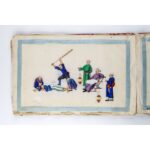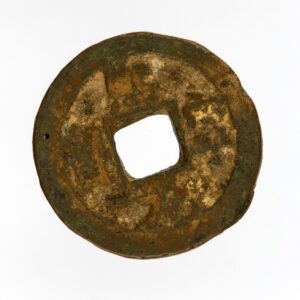Painting Playing an instrument
The first picture from an album of Chinese paintings of the everyday lives of court ladies, showing them playing instruments in a house from which a circular door leads to an outdoor garden. There are inscriptions on the two pillars inside the house, treating of joy and delight, which, together with the fragrant scents of the garden, add to the feeling of well-being.
These kinds of paintings depicting various aspects of Chinese society were very popular with foreign tourists. When Western European countries forced China to open its ports and trade more freely after the Opium Wars in the mid-19th century, the number of people of different professions (soldiers, sailors, merchants, missionaries and travellers) visiting these places increased. Travel became more affordable and opened the door to members of the middle class, who increasingly felt the need to buy souvenirs and other items to take home when they returned. Artists in Canton had a centuries-old tradition of producing ... more
The first picture from an album of Chinese paintings of the everyday lives of court ladies, showing them playing instruments in a house from which a circular door leads to an outdoor garden. There are inscriptions on the two pillars inside the house, treating of joy and delight, which, together with the fragrant scents of the garden, add to the feeling of well-being.
These kinds of paintings depicting various aspects of Chinese society were very popular with foreign tourists. When Western European countries forced China to open its ports and trade more freely after the Opium Wars in the mid-19th century, the number of people of different professions (soldiers, sailors, merchants, missionaries and travellers) visiting these places increased. Travel became more affordable and opened the door to members of the middle class, who increasingly felt the need to buy souvenirs and other items to take home when they returned. Artists in Canton had a centuries-old tradition of producing artwork for the Western market, such as paintings on canvas and paper and a variety of glass and ivory products, but these were more expensive to produce and therefore could only be purchased by wealthier ship captains and merchants. Cheaper souvenirs were needed, and these smaller paintings on paper of the native tongcao 通草 tree (Tetrapanax papyrifer) proved to be a successful combination of affordable yet attractive souvenirs of various aspects of Chinese society. (NVS)



































Do you have a comment or additional information about the subject?